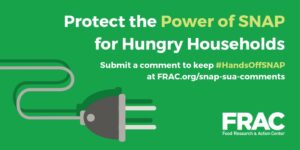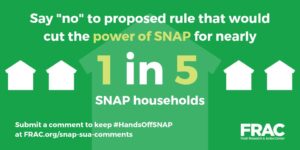October 18, 2019
Two recent articles shed light on the struggles that many U.S. households have with paying for food and utilities. A New York Times profile of four middle-class American families’ budgets reveals food and utility costs comprise significant portions of those households’ expenditures. Per a CalMatters news article, nearly half (49 percent) of a $500 cash grant given to low-income families during a California pilot program went towards covering food and utility costs (38 percent and 11 percent of the grant, respectively).
Despite signs that the U.S. is experiencing modest progress in driving down rates of food insecurity and poverty, it’s evident that far too many households still struggle to meet basic needs, like food and utilities. Ignoring that fact, the Trump administration has proposed its third Supplemental Nutrition Assistance Program (SNAP) rule this year, this one threatening to deepen the heating or eating dilemma for many more low-income households.

When households use some of their resources to pay for shelter and utility costs, those funds are not available to purchase groceries. SNAP considers the shelter and utility expenses of each SNAP household when determining its benefits. Under current law, states adjust household benefits based on a state-specific Standard Utility Allowance (SUA) calculated by the state and approved by the U.S. Department of Agriculture (USDA). Current policy allows variances in SUAs to accommodate for state differences in calculating utility costs and rates.
The proposed rule would standardize SUA calculations across the country, eliminating state flexibility. According to the administration’s own analysis, the proposed rule would lower monthly SNAP benefit allotments for 19 percent of SNAP households, disproportionately jeopardize access to benefits for older Americans and people with disabilities, and slash $4.5 billion worth of SNAP benefits over five years.

USDA’s SUA rulemaking is yet another ill-considered attempt by the administration to sidestep the will of Congress and erode SNAP benefits. USDA should be strengthening SNAP and its positive impacts on food security, health, well-being, and economic activity, not cutting already-meager benefits. This additional attack on SNAP will only lead to a hungrier, poorer, and sicker nation.
Constructive policy alternatives are available:
- USDA can work with states to improve their SUAs under the current rules; and
- Congress could pass H.R.1368 — a bill that would base SNAP benefit calculations on a more adequate market basket and allow families with children to deduct more of their shelter costs in their SNAP benefits calculations.
Use FRAC’s resources and comment tool to submit a comment in opposition to the administration’s SUA proposal that would make it harder for people to heat and eat. The deadline for submitting a comment is December 2.


